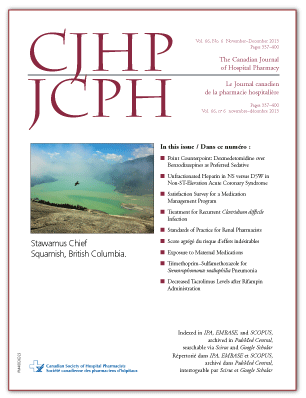Effectiveness of Unfractionated Heparin in Normal Saline versus Dextrose for Achieving and Maintaining Therapeutic Anti–Factor Xa Levels in Patients with Non-ST-Elevation Acute Coronary Syndrome
DOI:
https://doi.org/10.4212/cjhp.v66i6.1299Keywords:
unfractionated heparin, acute coronary syndrome, normal saline, dextrose, anti-Xa, héparine non fractionnée, syndrome coronarien aigu, solution physiologique saléeAbstract
ABSTRACT
Background: Unfractionated heparin (UFH) administered by IV infusion is effective in preventing myocardial infarction and death after non-ST-elevation acute coronary syndrome. At the authors’ centre, preparations of UFH in 0.9% sodium chloride (normal saline; UFHNS) were used during a shortage of commercially available UFH in dextrose 5% in water (UFH-D5W), the usual preparation. Anecdotal observations raised concerns about the effectiveness of the saline-based preparation in achieving minimally therapeutic anticoagulation.
Objective: To compare the effectiveness of UFH-NS and UFH-D5W for achieving and maintaining therapeutic anti–factor Xa levels in patients with non-ST-elevation acute coronary syndrome.
Methods: A retrospective cohort study was conducted with 2 groups of 100 consecutive patients who received either UFH-NS or UFH-D5W for a minimum of 24 h after non-ST-elevation acute coronary syndrome in accordance with a weight-based dosing nomogram.
Results: A minimally therapeutic level of anti-Xa (≥ 0.31 IU/mL) was achieved within 24 h for 92% of the patients receiving UFH-D5W and 67% of those receiving UFH-NS (absolute risk difference 25%, 95% confidence interval [CI] 13.4%–36.6%; p < 0.001). Infusion of UFHNS was associated with lower probability of achieving minimally therapeutic anticoagulation (hazard ratio [HR] 2.30, 95% CI 1.68–3.15; p < 0.001) and maintaining therapeutic anticoagulation (HR 2.31, 95% CI 1.69–3.17; p < 0.001) relative to UFH-D5W. Significant differences in the numbers of patients with subtherapeutic and therapeutic anticoagulation, favouring UFH-D5W, were observed at each of the first, second, and third anti-Xa measurements (p < 0.05). Patients receiving UFH-NS required a greater median number of adjustments to the infusion rate during the first 48 h (1.0 v. 0.5 adjustment per day, p < 0.001). There was no difference between groups in terms of major reductions in hemoglobin.
Conclusions: Infusion of UFH-NS was inferior to UFH-D5W for achieving and maintaining therapeutic anticoagulation in patients with non-ST-elevation acute coronary syndrome. Until further study,
RÉSUMÉ
Contexte : La perfusion intraveineuse d’héparine non fractionnée (HNF) est efficace pour prévenir l’infarctus du myocarde et la mortalité après la survenue d’un syndrome coronarien aigu sans élévation du segment ST. Au centre hospitalier des auteurs, des préparations de ce médicament dans du chlorure de sodium à 0,9 % (solution physiologique salée [SP]; HNF-SP) ont été utilisées lors d’une pénurie de solutions commercialisées d’HNF dans du dextrose à 5 % dans l’eau (HNF-D5E) d’usage habituel. Quelques observations ont soulevé des inquiétudes quant à l’efficacité des préparations à base de SP pour obtenir une anticoagulation thérapeutique minimale.
Objectif : Comparer l’efficacité de l’HNF dans la SP et le D5E pour obtenir et maintenir des concentrations thérapeutiques d’anti-facteur Xa chez des patients ayant subi un syndrome coronarien aigu sans élévation du segment ST.
Méthodes : Une étude de cohorte rétrospective a été menée à partir de deux séries consécutives de 100 patients qui ont reçu de l’HNF dans une SP ou du D5E pendant un minimum de 24 heures après la survenue du syndrome coronarien aigu sans élévation du segment ST, selon un nomogramme posologique en fonction du poids.
Résultats : Des concentrations thérapeutiques minimales d’anti-Xa (≥ 0,31 UI/mL) ont été obtenues en 24 heures chez 92 % des patients ayant reçu l’HNF-D5E et chez 67 % de ceux ayant reçu l’HNF-SP (différence de risque absolu de 25 %, intervalle de confiance [IC] à 95 % de 13,4 % à 36,6 %; p < 0,001). La perfusion de la préparation à base de SP a été associée à une probabilité plus faible d’obtenir une anticoagulation thérapeutique minimale (rapport de risque [RR] de 2,30, IC à 95 % de 1,68 à 3,15; p < 0,001) et de maintenir une anticoagulation thérapeutique (RR de 2,31, IC à 95 % de 1,69 à 3,17; p < 0,001) par rapport à la préparation dans du D5E. Des différences significatives dans le nombre de patients ayant obtenu une anticoagulation thérapeutique et subthérapeutique, en faveur de l’HNF-D5E, ont été observées à chacune des premières, deuxièmes et troisièmes mesures des concentrations d’anti-Xa (p < 0,05). Les patients ayant reçu l’HNF-SP ont requis un nombre médian supérieur d’ajustements de la vitesse de perfusion pendant les 48 premières heures (1,0 contre 0,5 ajustement par jour, p < 0,001). Il n’y avait aucune différence entre les groupes en termes de réductions importantes de l’hémoglobine.
Conclusions : La perfusion d’HNF-SP s’est révélée inférieure à celle de l’HNF-D5E pour obtenir et maintenir une anticoagulation thérapeutique chez les patients ayant subi un syndrome coronarien aigu sans élévation du segment ST. Jusqu’à ce que d’autres études soient menées, la perfusion d’héparine dans une solution physiologique salée doit être utilisée avec circonspection et les patients doivent être surveillés étroitement afin d’assurer l’obtention en temps opportun et le maintien d’une anticoagulation thérapeutique.
Downloads
Published
Issue
Section
License
Copyright © Canadian Society of Healthcare-Systems Pharmacy.
After publication of a manuscript in the CJHP, the authors of the manuscript must obtain written permission from the CSHP (publications@cshp.ca) before reproducing any text, figures, tables, or illustrations from the work in future works of their own. If a submitted manuscript is declined for publication in the CJHP, all said rights shall revert to the authors. Please note that any forms (e.g., preprinted orders and patient intake forms) used by a specific hospital or other health care facility and included as illustrative material with a manuscript are exempt from this copyright transfer. The CJHP will require a letter from the hospital or health care facility granting permission to publish the document(s).










